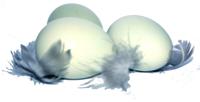History Of Blue Eggs
The poultry world was first alerted to the existence of blue egg laying hens by Prof.Salvador Castello Carreras when addressing the meeting of the first World Poultry Congress at The Hague in 1921. The professor had noticed these hens whilst visiting Chile in 1914, and he assumed that they were decendents of the hens seen in South America by the Missionaries of the sixteenth and seventeenth centuries at the time of the Spanish conquest.
When the birds were recorded as being ‘quite different from the Castilian hen’. This, together with the fact that many of the hens sported ‘muffs’, promped Carreras to propose the name ‘Gallus Inauris’.
In his article, ‘The Araucano, The Blue-Egged Fowl of Chile’, C.A.Finsterbusch stated that, ‘it has been fairly proved that there were no fowls there before the advent of the white man in S.America’. His evidence suggested that the Spanish poultry originally imported were subsequently diluted by Balinese birds introduced by Dutch pirates, and points out that Oriental type birds are common among the mongrel poultry population of Chile.
Commenting on the ‘blue’ egg he states that ‘these strange coloured shells are, however, by no means of uniform tint. There are bluish, blue-grey, purplish, greenish, greyish green, and finally greenish eggs speckled with brown, which indicates clearly some precedent colour influence, either abnormal or incidental’. Finsterbusch suggested that the greenish and bluish shell colour is due to the loss of the red pigment brought in by the imported stock from Bali. However, his explanation does not agree with the genetical data gathered by Prof. Punnett at Cambridge.

